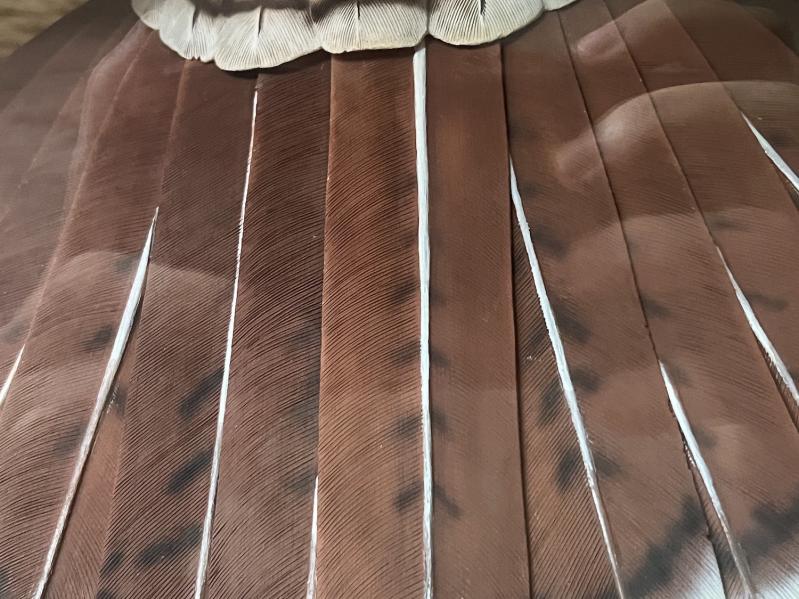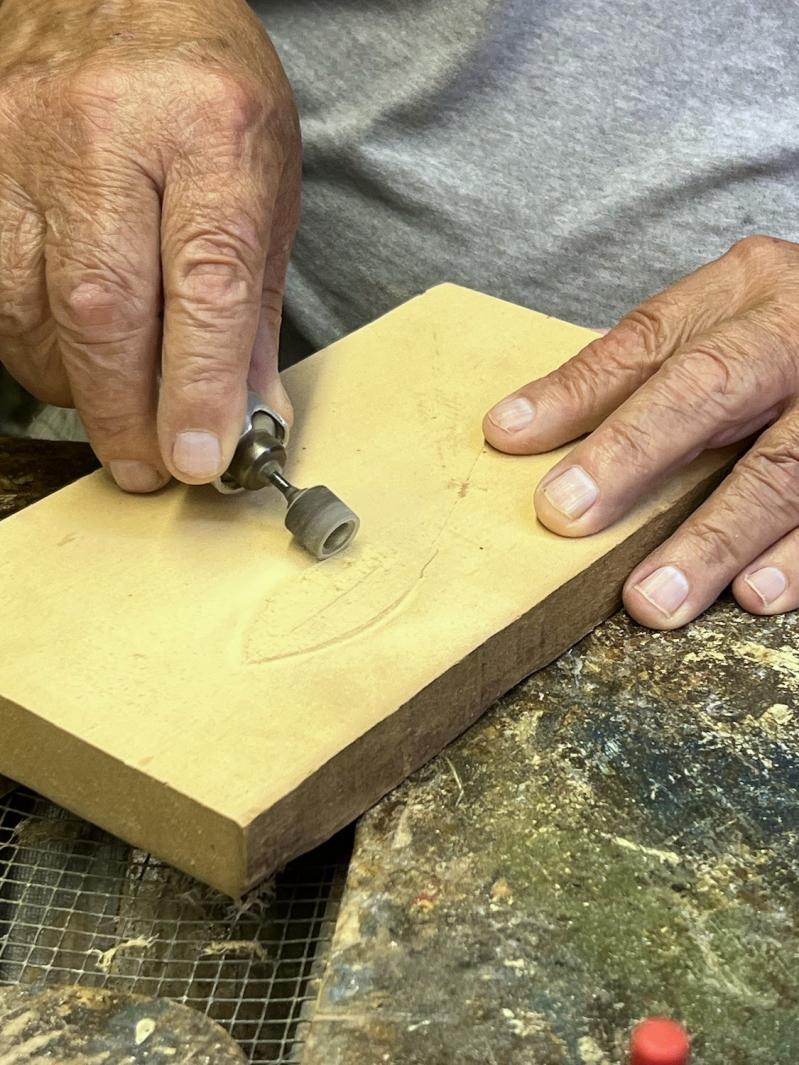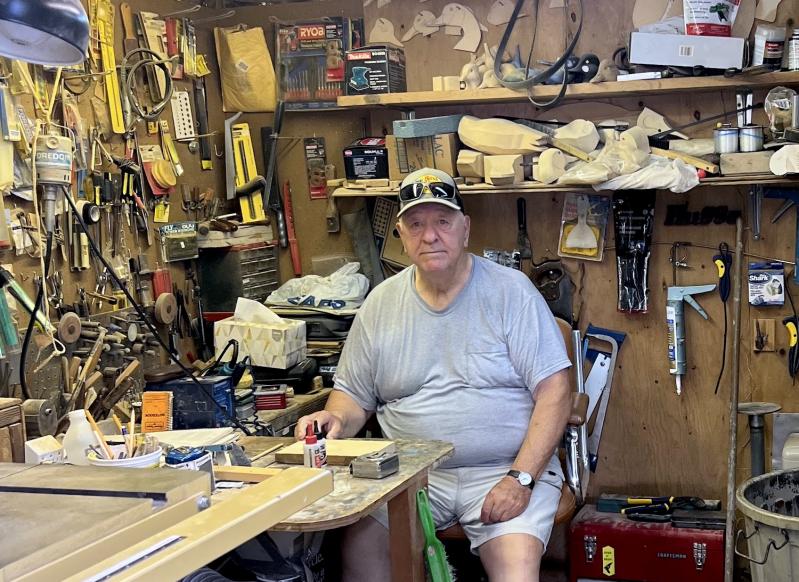Robert Greene keeps his masterpiece, a life-size red-tailed hawk, inside a glass case to the left of his front door. It is the first thing he shows visitors when they walk in. A renowned decoy carver who lives in Springs, he estimated that the piece, which could be mistaken for taxidermy, took him 550 to 600 hours to carve. Its wings are partially extended, as if it’s about to take flight. Everything was chiseled from a block of wood — even the chipmunk emerging from a hollow in the stump that the bird is mounted on — and the oak leaves and acorns that surround its base.
Mr. Greene, who goes by Bob, is known among his Bonacker friends as Hugger for his powerful arms and large hands, but he has a careful, calculated touch to carve with such detail.

His house is curated. Three taxidermied buck heads look out from a brick wall above the fireplace; a shotgun is mounted on the mantel below. Carved ducks — a red-breasted merganser, a green-winged teal hen, a mandarin — are in a display case in the laundry room. His own paintings line the walls. They are mostly vibrant landscapes or paintings of animals, imbued with a reverence for the quiet beauty of nature. One of them depicts a flock of redhead ducks migrating over a body of water; two carved ducks stick out from the painting so that they physically emerge into the foreground.
In his recent book, “Artistry of Louisiana Decoy Carvers: Old and Contemporary,” Harvey J. Lewis (this reporter’s great-uncle) writes, “Decoys have been recognized as a museum-worthy art form. No longer are wooden decoys simple hunting tools,” but rather “collectible art, suitable for display in the home.”
That is certainly true of Mr. Greene’s work.
He carves the ducks in his shed, and then paints them in his basement workshop. Taxidermied birds that he’s shot, and birds that he’s carved, take up every bit of space (including the ceiling), except for a desk full of tools.

His most recent creation, a group of six lesser yellowlegs, was on a table in the center of this room. Their bodies were rounded, proportional, colored perfectly, each of them with a different gesture, nearing photorealistic. He compared this to one of his oldest carvings, four sanderlings which are shorebirds like the lesser yellowlegs; these were blocky and undetailed.
According to “Artistry of Louisiana Decoy Carvers: Old and Contemporary,” “The duck decoy was invented by the Native Americans more than 2,500 years ago. The oldest were found in a mountainous cave in Nevada. They were made of reeds woven together and filled with feathers.” Nowadays, there are two main types of decoys: decorative decoys and hunting decoys. Hunting decoys need to be accurate enough to fool ducks. Decorative decoys are supposed to have lifelike detail; this is what Mr. Greene specializes in.

He burns the individual barbs of each feather into the wood with a fine-pointed wood burner. He primes the wood with gesso, then he paints the bird in stages, favoring the airbrush as a tool to blend colors. The last thing he paints are the secondary feathers which often have a dash of bright color, such as the bright green in the green-winged teal, whose plumage is mostly brown.
He also creates “smoothies,” which are decoys that have no texturing; rather, the individual lines and patterns are painted on.
His shed, where he carves the decoys, is the only part of his home that isn’t tidy. There are chunks of wood on the floor, some of his earliest decoys — carved with a hatchet — and half-finished duck heads emerging from cork and tupelo wood, a radio, tools, his camouflage carving apron, and a set of drawers with various sizes and colors of glass eyes.
The first thing Mr. Greene does when carving is outline the bird on a block of wood. He usually carves the head from a separate piece of wood and then attaches it using epoxy and a dowel.
He uses a band saw, a big machine with a vertical blade, to cut large chunks off. For finer carving he puts the decoy in a vice that rotates, so he can turn it however he wants while he works, and uses a smaller saw to cut pieces off.
He’s built a table with a fan in it to suck up sawdust while he works. Hanging above this table by a bungee cord is a Foredom carving device whose speed is controlled with a foot pedal. He uses this tool to outline the individual feathers. Sometimes he uses a knife. Then he smooths it using an electric sander. He does the finest carving with a Gesswein device, for which he has an array of tiny diamond drill bits. He textures the feathers with this tool, and then adds more texture with the burner. “It just puts another dimension in there,” said Mr. Greene. “It puts a deeper mark than the burner does, so you have two different textures.” He also uses the Gesswein for detailed “bill work and around the eyes.”
Not only does he get the general outline of the ducks from books, but he also gets the colors and textures — “the pattern” — just right by studying them. He has bits of practice work all over the place, such as a bunch of duck heads that are not attached to bodies. He makes the head feathers out of turkey beards.
He started duck-hunting with his father when he was a teenager. He’ll be turning 85 in December and still fishes and duck hunts with his son and grandson. There is a fishing boat in his yard, and lobster traps stacked in the corner. He has a tarp shed with fishing rods and hunting decoys inside it, and he has a camouflage duck blind trailer that he can tow out into the fields for hunting.
According to Mr. Greene, in order to be a decoy carver, “You gotta know the wood, you gotta be a halfway decent carver, you gotta be a decent painter. . . and you gotta be an artist.”
He was a tank driver in the Army, worked at Bistrian Gravel for many years, and retired from the Town Highway Department as a foreman in 2001.

He began carving while he was a heavy equipment operator for Bistrian Gravel before that. “I met a guy from Hampton Bays named Fred,” said Mr. Greene. “He was working on some heads. He used to drive a lumber truck . . . at lunch time he would be sanding.” Interested, Mr. Greene started carving in his free time with a jackknife and a coping saw, which was all he had. “There was like seven of us out here [who] used to carve,” said Mr. Greene. Now he is the only carver left.

He started entering birds as a novice in the national duck carving shows in Huntington. “I started winning some ribbons. I went up in classes. . . . Here’s where I’m at today, 50 years later,” he said. His red-tailed hawk got second best in show at the Toms River Art and Decoy Festival. A few times, he entered the Ward World Championship, which is like the Olympics of wildfowl carving, on Maryland’s Eastern Shore, but he stopped competing because the competitions got “too political.”
“You get tired of carving for judges because a lot of these judges are teachers and they teach students and then the students enter the show,” and the teachers secretly favor their students, he said.
Mr. Greene always considered carving to be a hobby, but he does take commissions. His advertising is word of mouth, and he was recently asked to create a black duck for $1,500.

